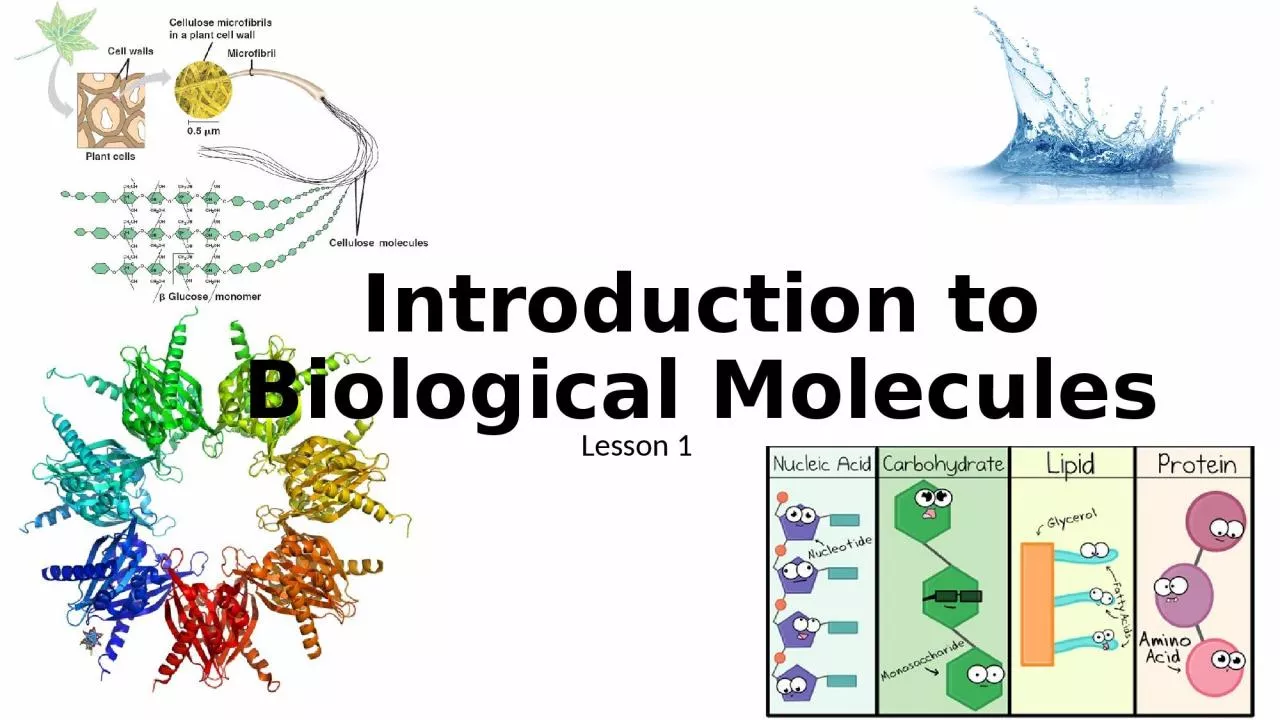

Lesson 1 b the concept of monomers and polymers and the importance of condensation and hydrolysis reactions in a range of biological molecules c the chemical elements that make up biological molecules ID: 1034783
Download Presentation The PPT/PDF document "Introduction to Biological Molecules" is the property of its rightful owner. Permission is granted to download and print the materials on this web site for personal, non-commercial use only, and to display it on your personal computer provided you do not modify the materials and that you retain all copyright notices contained in the materials. By downloading content from our website, you accept the terms of this agreement.
1. Introduction to Biological MoleculesLesson 1
2. (b) the concept of monomers and polymers and the importance of condensation and hydrolysis reactions in a range of biological molecules (c) the chemical elements that make up biological molecules To include: C, H and O for carbohydrates C, H and O for lipids C, H, O, N and S for proteins C, H, O, N and P for nucleic acids(p) the key inorganic ions that are involved in biological processes To include the correct chemical symbols for the following cations and anions: cations: calcium ions (Ca2+), sodium ions (Na+), potassium ions (K+), hydrogen ions (H+), ammonium ions (NH4 +) anions: nitrate (NO3 –), hydrogencarbonate (HCO3 –), chloride (Cl –), phosphate (PO4 3–), hydroxide, (OH–).Spec:
3. Need TO BOokMolymodsMini whiteboardsCard sortReproPrint slide 12 for students to use
4. Module 2.1.2 Biological MoleculesWaterCarbohydratesProteinsLipids
5. FLIP LEARNING: VideoWatch the video and answer the questions on the worksheethttp://www.youtube.com/watch?v=H8WJ2KENlK0
6. Intro to Biological MoleculesLearning objectiveTo know about biological molecules Success CriteriaI can state chemical elements that make up biological molecules I can identify key inorganic ions involved in biological processesDescribe the general features of condensation and hydrolysis reactions
7. Biological molecules essential for life…Starter CarbohydratesProteinsLipids Nucleic Acids Vitamins & Minerals WaterNow, sort match the molecules to their function
8. CarbohydratesEnergy storage and supplyProteinsStructure, transport, enzymes & antibodiesLipidsMembranes, energy supply & insulationVitamins & MineralsForm parts of larger moleculesNucleic acidsInformation moleculesWaterSupport, takes part in reactions & transportAnswers
9. What is a monomer? A small molecule which binds to many other identical molecules to form a polymer What is a polymer? A large molecule made from many smaller molecules called monomersKey Questions
10. Complete the table below, using your own knowledgeName of MonomerName of PolymerCarbohydrateProteinDNAGroup Task: Prior Knowledge Assessment / Flip Learning Check
11. MonomerPolymerCarbohydrateMonosaccharidePolysaccharideProteinAmino acidPolypeptideDNANucleotideDNA and RNAAnswers
12. Intro to Biological MoleculesLearning objectiveTo know about biological molecules Success CriteriaI can state chemical elements that make up biological molecules I can identify key inorganic ions involved in biological processesDescribe the general features of condensation and hydrolysis reactions
13. CationsPositive ionLost an electron or electrons AnionsNegative ionGained an electron or electrons SC: Identify key inorganic ions involved in biological processesInorganic Ions
14. Calcium ionsChlorideSodium ionsPotassium ionsHydrogen ionsHydroxide Nitrate*Hydrogen Carbonate*Ammonium ions*Phosphate*Task: Sort into Anion and Cations Challenge: State the symbol for each oneInorganic IonsSC: Identify key inorganic ions involved in biological processes
15. Inorganic IonsSC: Identify key inorganic ions involved in biological processesAnionsCations Calcium ions - Ca2+Chloride – Cl-Potassium ions - K+Hydroxide - OH-Sodium ions - Na+Nitrate – NO3-Hydrogen ions - H+Hydrogen Carbonate - HNO3-Ammonium ions – NH4+Phosphate – PO4-
16. What is an element?Chemical Elements – think, pair, share SC: I can state chemical elements that make up biological molecules
17. CarbohydratesLipidsProteinsNucleic Acids (e.g. DNA)TASK: What elements are in each molecule? SC: I can state chemical elements that make up biological molecules
18. AnswersCarbohydratesC, H & OLipidsC, H & OProteinsC, H, O, N & SNucleic AcidsC, H, O, N, & PTASK: What elements are in each molecule? SC: I can state chemical elements that make up biological molecules
19. Carbon can form 4 bondsNitrogen can form 3 bondsOxygen can form 2 bondsHydrogen can form 1 bondThis info will be really useful when you have to draw diagrams of molecules later in the moduleForming BondsSC: I can state chemical elements that make up biological molecules
20. All biological molecules undergo two types of reaction:Condensation reaction– two molecules are joined together with the removal of a water molecule. Water is PRODUCED in the reaction Hydrolysis reaction – this is when two molecules are split apart with the addition of water Reactions SC: I can describe the general features of condensation and hydrolysis reactions
21. Condensation Reaction (to put them together) Forms a covalent bond between the two moleculesA water molecule is producedCondensation Reactions SC: I can describe the general features of condensation and hydrolysis reactions
22. Hydrolysis Reaction (to split them apart)Breaks the bondUses up a water moleculeHydrolysis Reactions SC: I can describe the general features of condensation and hydrolysis reactions
23. Model hydrolysis and condensation using the molymods, make sure you get the teacher to check your model before you move onto the next oneTASK: In pairs…SC: I can describe the general features of condensation and hydrolysis reactions
24. QUICK QuizWhat are the two types of reactions in biological molecules?Condensation and HydrolysisWhat are the reactants of a hydrolysis reaction?Polymer and waterWhat are the products of a hydrolysis reaction?MonomersWhat are the reactants of a condensation reaction?MonomersWhat are the products of a condensation reaction?Polymer and water- Describe the general features of condensation and hydrolysis reactions
25. For Friday, please watch the following video and answer the questions on the sheet.The link to the video, and the sheet, will be put on the homework app. FLIP LEARNING
26. PlenaryIn groups of 4, write a summary of the 2 SC, each student with a different coloured penEach student writes the summary for the 1st one and passes it onNext student can correct previous student and write next SCState chemical elements that make up biological moleculesIdentify key inorganic ions involved in biological processes- Describe the general features of condensation and hydrolysis reactions